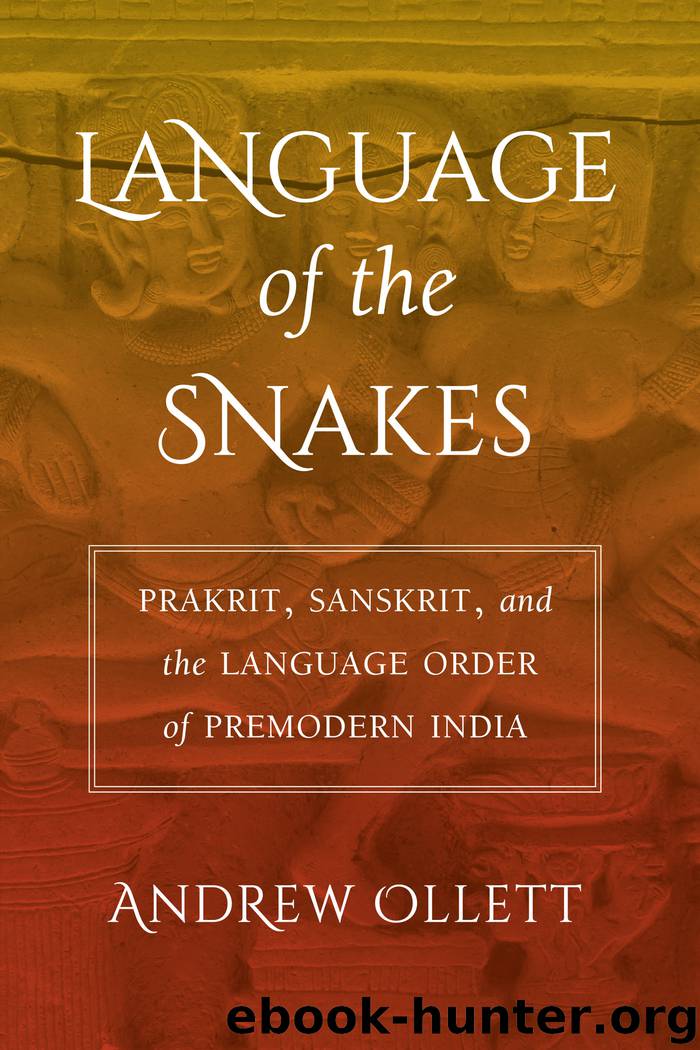Language of the Snakes by Ollett Andrew

Author:Ollett, Andrew
Language: eng
Format: epub
ISBN: 9780520968813
Publisher: University of California Press
GRAMMAR, METAGRAMMAR AND THE REGIONAL
One of these foundational concepts is the division of Prakrit into three categories. The earliest discussions of such a division occur in Bharata’s Treatise on Theater and in Daṇḍin’s Mirror of Literature, and luckily Daṇḍin’s tenth-century commentator Ratnaśrījñāna quotes several passages from Harivṛddha on the subject.41 All of these discussions imply what Ratnaśrījñāna makes explicit: under this analysis, Sanskrit is singular, and Prakrit is plural. Its plurality, however, does not consist in the plurality of Prakrit languages such as Śaurasenī and Māgadhī, but in the plurality of its “modes” (prakāra), the aspects in which Prakrit appears in relation to Sanskrit. This point bears emphasis, because it might at first appear that Prakrit’s plurality makes it an open-ended category for an endless variety of language practices, whereas in my view it has the exact opposite effect: it is a precondition for its precise grammatical description.42 “Sanskrit-identical” Prakrit (Daṇḍin’s tatsama) appears identical to Sanskrit. “Sanskrit-derived” Prakrit (Daṇḍin’s tadbhava) can be understood as a systematic modification of Sanskrit. Finally, “Regional” Prakrit (Daṇḍin’s deśī), has no perceptible relation to Sanskrit at all.43
These three categories refer, in all of these discussions, to the Prakrit language. Ratnaśrījñāna reproduces Harivṛddha’s examples: hari- “Viṣṇu,” hara- “Śiva,” and kamalā- “Lakṣmī” are identical in both Sanskrit and Prakrit, allowing for some differences in their case-endings; mahinda- “Indra,” sindhava- “of Sindh,” and bahira- “deaf” can be thought of as “derived” from the corresponding Sanskrit forms (mahendra-, saindhava-, and badhira-); bokkaṇa- “crow,” kaṃkelli- “Aśoka tree,” ciriḍḍihilla- “curds,” and sitthā- “bow-string” have no apparent relation to the Sanskrit words that are current in those meanings. These categories, however, are not limited to the analysis of lexical units. In principle, they apply to “all aspects of the structure” of the language.44 I would press this point further: the paradigmatic status of language meant that the categories developed for language could apply to a wide range of other practices, and the threefold analytic could—and in limited ways did—function as a general analytic of culture.
A closer look at these categories shows how they are indebted to the analysis of language but not confined to it. One function that they perform is comparing two forms and converting the difference between them into one of three values. Crucially, however, the differences between individual forms are a function of the global differences between the domains from which these forms are drawn. They are structural. In Harivṛddha’s examples, the different phonological systems of Sanskrit and Prakrit are what generate the particular differences between selected lexical forms. This analysis is exhaustive and non-overlapping: every single Prakrit word can be brought under one, and only one, of these three categories. The analysis can therefore be thought of as a way of characterizing the relation between a given Sanskrit “input” and a desired Prakrit “output,” provided that exactly the same rules—in this case the rules of Prakrit phonology—apply equally to all inputs. “Sanskrit-identical” are forms to which the rules apply vacuously. “Sanskrit-derived” are forms in which the input and output differ, but in which those differences can be brought under a regular description.
Download
This site does not store any files on its server. We only index and link to content provided by other sites. Please contact the content providers to delete copyright contents if any and email us, we'll remove relevant links or contents immediately.
| African | Asian |
| Australian & Oceanian | Canadian |
| Caribbean & Latin American | European |
| Jewish | Middle Eastern |
| Russian | United States |
4 3 2 1: A Novel by Paul Auster(11078)
The handmaid's tale by Margaret Atwood(6876)
Giovanni's Room by James Baldwin(5896)
Big Magic: Creative Living Beyond Fear by Elizabeth Gilbert(4736)
Asking the Right Questions: A Guide to Critical Thinking by M. Neil Browne & Stuart M. Keeley(4602)
On Writing A Memoir of the Craft by Stephen King(4223)
Ego Is the Enemy by Ryan Holiday(4004)
Ken Follett - World without end by Ken Follett(3984)
The Body: A Guide for Occupants by Bill Bryson(3821)
Bluets by Maggie Nelson(3725)
Adulting by Kelly Williams Brown(3682)
Guilty Pleasures by Laurell K Hamilton(3602)
Eat That Frog! by Brian Tracy(3529)
White Noise - A Novel by Don DeLillo(3443)
The Poetry of Pablo Neruda by Pablo Neruda(3373)
Alive: The Story of the Andes Survivors by Piers Paul Read(3322)
The Book of Joy by Dalai Lama(3239)
The Bookshop by Penelope Fitzgerald(3238)
Fingerprints of the Gods by Graham Hancock(3224)
